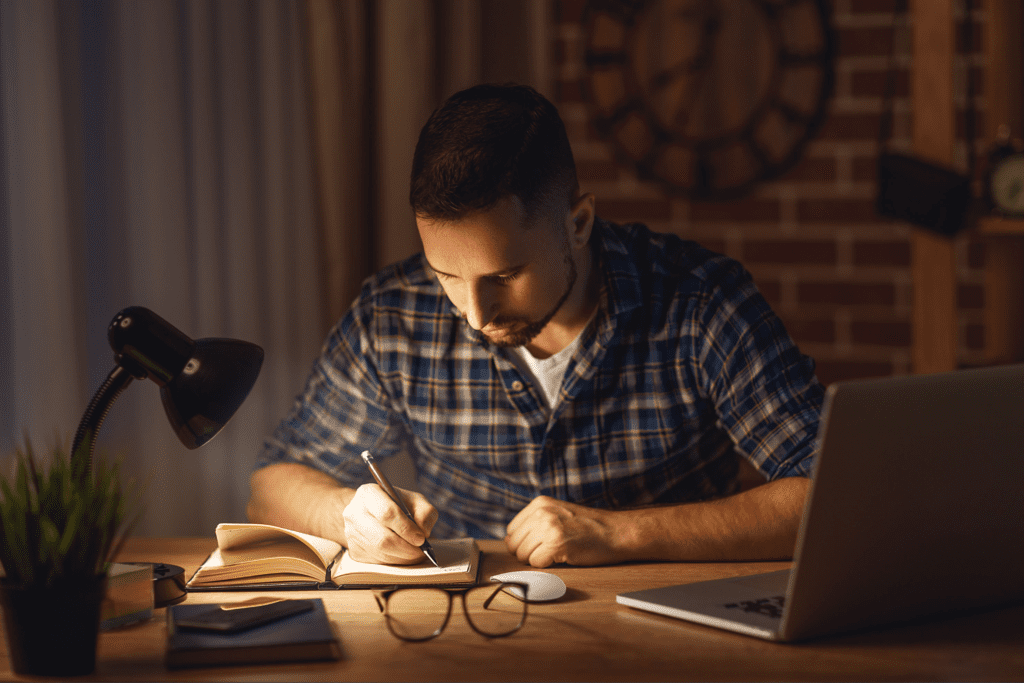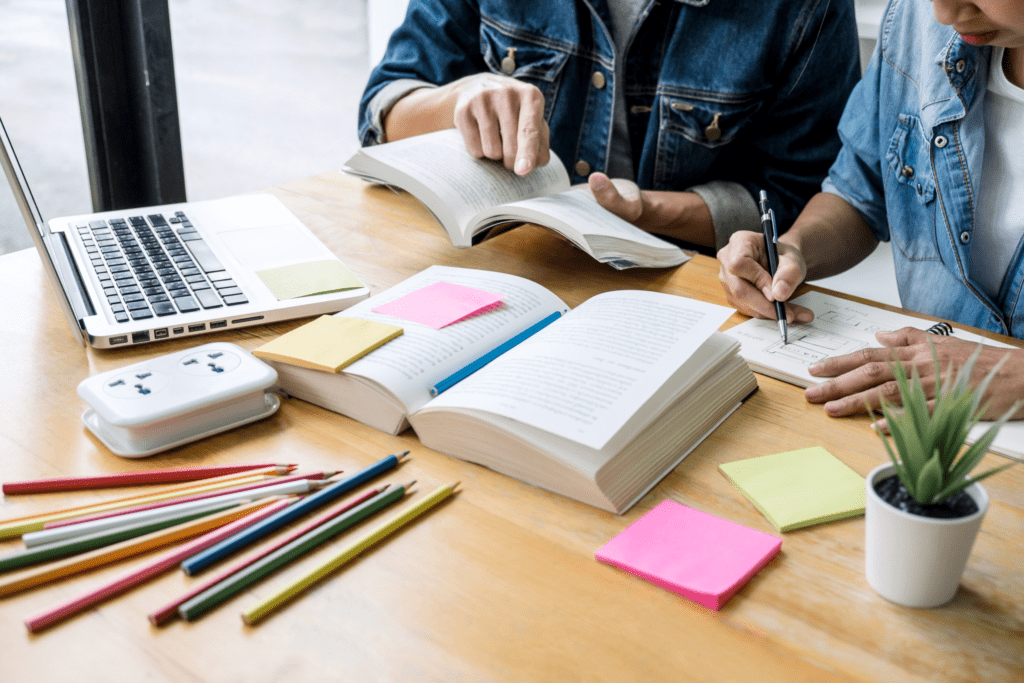You don’t need study tips, you need a study strategy.
Being able to study effectively requires a lot of planning. To do this right, you need to know a bit about yourself and be willing to do some trial and error. If you’re looking for some quick tricks because you’re surfing the web while procrastinating, click off now and get your work done. If you’re looking for a genuine way to get the most out of your study time and trick your brain into doing the best it can, keep on reading.
Quality over quantity.
The first thing that I cannot emphasise enough is that studying more doesn’t necessarily give a good result. You want to make sure that you are clever about the way that you study to get the best bang for your buck.

Learning new things is difficult. It puts your body under stress and requires a lot of energy to literally restructure your brain. Think about your brain not as something that you fill with facts and knowledge, but rather as a web of connections. In order to learn something new, you need to build new connections and try to get rid of the ones that are incorrect. Not only that, but you then need to strengthen those new connections to make sure that they stick.
If you spend a lot of time studying in a way that is inefficient, you are going to be expending more energy for less gain. If you have pulled an all-nighter to study for an upcoming exam, I’m sure you’ve felt what it’s like to try and keep pouring new stuff into your head and it seems to just leak straight out of your ears.
The following tips will help you get the most out of your study. Some of them may seem a little odd because most of them are not actually about the studying itself. These things are essential to keep in mind to make the most out of your time and get the best result possible.
- Relate to what you already know and understand.
- The brain remembers patterns.
- Get plenty of rest.
- Work on your own schedule.
- Know when to take a break.
- Consistency is key.
- Get your space right.
Relate to what you already know and understand.
So many of my students simply repeat concepts and figures in their heads over and over again thinking that there is a magical number that they will reach where it will stick. They will sit there and write out the same notes again and again thinking that remembering these word for word will get them the results that they want. The fact is that this is great if you want to memorise a script, but not great if you want to learn.
These students may be able to remember definitions really well, but they often struggle to apply concepts. As soon as these students encounter a situation that they haven’t seen before, they struggle to solve the problem even if they have all the required concepts in their heads.

What you need to do is fit what you are trying to learn into how you understand the world to work. Concrete examples and analogies help a lot with this, although it can be a challenge as you get into more complicated concepts. I teach Chemistry, and I find that personifying certain elements helps students understand. Certain elements really want to take electrons, and others really want to give. If two elements both want to take, they share and stick closely together because neither wants to let go. They need to be able to explain this in terms of valence electrons and electronegativity, but it’s easier once they can remember the concept a little better.
This concept known as constructivism states that students need to fit new knowledge into their picture of the world. Trying to learn new things without any kind of reference point that you already understand is incredibly difficult to do, and will take more effort and energy compared to being clever with how you approach new topics that you are trying to understand. If you’re trying to squish a square peg in a round hole and force a new concept to make sense, you can end up with a lot of misconceptions though. This is where tutors and teachers can really help to keep you on the right path.
The brain remembers patterns.
Aboriginal peoples in Australia are expert learners. They learn stories that go on for months word for word without any kind of formal writing system. I don’t mean that the plot of the story takes place over months, but that it takes months to physically tell the story. One of the key ways that they do this is through song. The Ancient Greeks did something similar. Their epics were meant to be remembered and recited out loud, something that seems ridiculously difficult today. The trick is that in the original language, they have a particular cadence and pattern to them that makes them easier to remember.
I’ve heard the joke told before that a particular student can remember all of the lyrics to their favourite rap song and recite them perfectly but can’t remember their times tables. This is because our brain works particularly well with patterns and rhythm. Many mnemonic devices rely on rhyme or other patterns such as alliteration. You can even argue that acronyms use the same concept to help you remember a list of words that link to concepts. Realising the power of patterns for learning will help you with the driest memorisation tasks.

It could be as simple as the chemical equation for photosynthesis. For those of you who haven’t done science in a while:
6CO2 + 6H2O → C6H12O6 + O2
This is one of the equations that I expect my students to memorise.
Linking back to fitting things into how the world works, you probably learnt in Primary school that plants breathe in carbon dioxide and breathe out oxygen for us to breathe. This gives you the first part of the equation.
CO2 → O2
One more thing is added to each side, and we know that the purpose of photosynthesis is to create energy for the plant to grow. This means that glucose needs to be one of the products. We need something else for the plant to be taking in, which is water from its roots.
CO2 + H2O → glucose + O2
Then you need to remember the number six. Everything has a six in it. There are six of each of the smaller molecules, and glucose is made of sixes as well. The only other number is 12 (which is double six) for the hydrogen because most organic molecules have more hydrogen than anything else.
6CO2 + 6H2O → C6H12O6 + 6O2
Isn’t that easier than repeating the equation over and over again to try and memorise it in a vacuum?
Get plenty of rest.
When you are studying to learn something new, you are trying to literally restructure your brain. If you’re trying to train a muscle, you can work out as much and as hard as you want but if you don’t make sure to eat and sleep, you’re just going to burn out and hurt yourself. It is incredibly similar to your brain.
Nutrition
You need to make sure that you are well rested and well fed while you are trying to learn new things. If you’re surviving off four hours of sleep and energy drinks, you’re not going to be learning as effectively as you could be. Our brain needs energy and rest to grow, so you need to look after it.

Fuelling your body with enough energy and calories is important, but so is getting enough micronutrients. Make sure you’re eating plenty of healthy food that works well for you. It may be worth testing different eating habits as well – some swear that intermittent fasting or keto are great for clearing brain fog, and others swear by high-quality carbohydrates to fuel the brain.
Over-studying
If you are trying to cram at the last minute, you may be able to get away with over-studying in the short term. If you try and do it long-term though, you’re going to find that your health suffers. It’s very hard to build a skill when you’re struggling to get out of bed because you feel so awful. I tell my senior high school students all the time that there is a point in the night before a big exam that actually going and having a good dinner and then going to sleep is going to help you much more than if you kept studying.
The power of napping
I’m definitely a napper. I love a good midday nap. I’m lucky enough that if I nap before 4 pm, it doesn’t affect my ability to get to sleep at night. Getting a good night’s rest is important but if you can get away with napping, I would definitely recommend it. Professional sports players make great use of naps during the day so if you’re training for a (mental) marathon, a nap between study sessions can do wonders.
Work on your own schedule.
Everyone works better at different points in the day. I’m a morning person and do my best work first thing after I get up while I’m having my first cup of coffee. I can work hard for three to four hours, and then moderately well for a few more hours, but then become pretty useless by around 2:30-3 pm. At school, homework after school never worked for me. I would get home and just stare at a screen because my brain had already shut off. I didn’t think at the time that I might be better off getting up an hour earlier to get some work done as I do now. Currently, I can get about three times as much work done between 7 and 8 am than I can between 3 and 4 pm.

I have friends who work entirely differently. They are really slow to wake up and get into their day and only really get going around 10:30. This same person will take a long break after work, and then come back to do the hard work just before midnight. This is the time that they can be the most efficient.
With studying (and work in general) efficiency is key. You only have so much time in the day, so much time in a semester, and so much energy to use for studying. Do a few experiments to find a time of day where you can just sit for a few hours and get stuff done and make the best possible use of that time slot. If you find that you don’t have any time where you are able to get any work done, then you need to go back a step and make sure that you’re looking after yourself.
There are of course other complicating factors, such as ADHD. These can require some more unique and tailored approaches.
Know when to take a break.
It’s probably sooner than you think.
Usually, getting distracted is a sign that you’re not ready to learn. If you’re finding the task difficult or boring then that’s another matter; you’re likely to look for distractions in this case no matter what you do. If you’ve been working hard for an hour or two though and are suddenly finding yourself checking your phone and staring out of the window, it’s probably time to take a break. What most people get wrong is that they don’t know how to take a break.
If you need a break from your study, it’s likely that you’re tired, have run out of energy, or need to process all of the new connections that you’ve just made in your brain. Taking a break to scroll through your phone for a bit is not going to help your process what you’ve just learned and be ready to start again, and you’ll often to find it even harder to concentrate when you do get back to work.
The trick is to figure out what you need. If you’ve been listening to music while you were studying, it might help to take out the headphones for a while. Going for a walk is a great way to process what you’ve been learning about and consolidate that learning. A snack might also be in order if you’re feeling a bit flat. Meditation is another good strategy to use to really relax and calm your mind when it’s trying to go a million miles an hour to get on top of everything. The trick with meditation is to not try it for the first time when you’re already overstimulated – practice when you’re calm, and then you’ll be good enough to calm yourself when you need to.

When I was in uni, I would have an intense study session for a few hours in the morning before hitting the gym and going home for a quick nap. The gym ensured that I wasn’t worrying and thinking about anything other than putting one foot in front of the other for a while, and the nap helped to recharge my batteries. Doing this meant that I could get at least four hours of very high-quality study in, as opposed to two good hours and then another six of procrastination.
Consistency is key.
If you’re studying in shorter bursts, you can’t just get away with leaving everything to the last minute. You will need to get into the habit of just starting more frequently.
There are a couple of different strategies that you can use to help you with this. The big one that worked for me was to get into the mindset of just sitting down. You don’t need to do anything but sit down. Open up the laptop. Now open your document. If you’re not cramming for the exam the night before, you can get away with convincing yourself that you only need to be there for as long as you can, and can take a break as soon as you need one.
A good way to make a new habit is to attach it to one that you already have. My brain checks out at around 2:30 pm most days, so I usually go for a walk. If I have something that I’m trying to write and need to get some extra time in, I’ll walk up to the local coffee shop, grab a wonderful cup of coffee, and just sit and open up my laptop. I’ll often potter around for a bit, maybe check my emails and have a look at what I’ve already written. Usually I end up writing a little bit at least, which is more than what I would have done if I were to stay sitting at my desk trying to force myself to do it.
I’ve gotten into the habit of doing this now, and I really look forward to it now. I see it as unwinding time as I can sit by myself and tick off that last thing that I needed to do in my day. Fitting extra work into your current schedule can be tough, so it’s easier to tack it on to something that you already do. Maybe after every lesson, you go and sit under a tree and go through your notes. Maybe you make sure not to use a highlighter while you’re in class so that you need to go back before the next lesson to do it – this is a small action, but if you can convince yourself to just start, it will become a lot easier.
Get your space right.
This one is very important and just like with your schedule, it’s going to take some trial and error. If you’re finding that you can’t study in your bedroom or you just procrastinate if you’re at the library, try something new!

I find that there isn’t one place that I work best; that I actually get sick of locations and need to change it up to be the most productive. I can usually sit in my office for the first part of the day, but then I start to drift away. I can change it up by ducking down to the local library, coffee shop, or park to sit and do some work. Sometimes even sitting in front of the TV with the family for a bit to answer my emails is enough to get me out of a rut.
If you need to work in a particular location, there are still ways that you can tweak your space. Try listening to music, and try not listening to music. Try different music and see if it affects how productive you feel. Do you like to have everything around you ready to access, or do you find it easier to work with a clear space and everything else on the floor next to you? These are all personal preferences and are worth experimenting with.
Use as little force as possible.
If you’re finding that the only way you can get your work done is to sit and force yourself to do it, check your strategy. Are you looking after yourself? Is your brain in the best state to learn? What can you do to make sure that you find this process as easy as possible?
Not only can struggling to study be a symptom of another health or well-being issue, but forcing yourself through what the brain often perceives as pain to do it is not good in the long run. It will affect your stress levels and physical health if you do it long term, and you might find that you lose your passion. This is just my opinion, but I think that while failing your college course is bad, finishing with perfect grades and then being so burned out that you never want to work in the field again is even worse.





